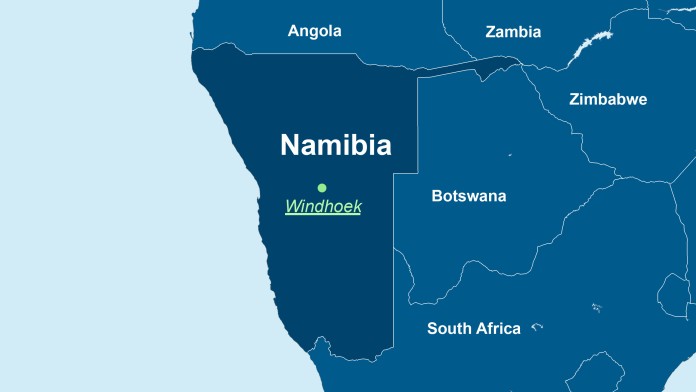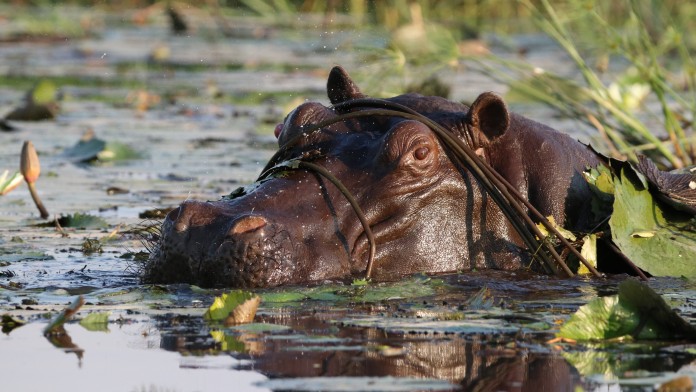
As of: 11/2022
Elephants, rhinos, gnus, lions – Africa’s best-known wildlife can be found in Namibia, as well as a huge number of less spectacular yet very rare species. In order to preserve this rich biodiversity and capitalise on the use of natural resources, the Namibian government has put environmental protection and sustainable economic development at the top of its national agenda. Numerous national parks protect biodiversity. KfW Development Bank is supporting this goal on behalf of the German Federal Government by financing an integrated conservation area management programme in Namibia’s national parks.

Tourism is a high priority for Namibia. This is because there is a lack of other sources of income, especially for the rural population who frequently suffer from poverty. The Namibian government therefore believes that the expansion and revaluation of tourism is an economic and societal opportunity.
One attraction is the country’s twelve national parks, which cover almost 140,000 square metres, more space than all of Germany put together. However, many parks were not managed efficiently at the start of the programme and were not sufficiently equipped to develop their full potential for both species protection and tourism. In addition, poaching and conflicts between humans and animals are a further burden on the environment and communities. Elephants regularly destroy maize fields, predators kill livestock on farms. This can lower the communities’ tolerance of wildlife. These risks must be tackled quickly and sustainably in order to preserve the wealth of the national parks.
The COVID-19 pandemic led to a sharp downturn in tourism, drying up a major source of income for Namibia. It was no longer possible to fund conservation activities, such as patrols against poaching.
In the fifth phase of the programme, which has been running since 2006, KfW supports the Bwabwata, Mudumu, Nkasa Rupara, Khaudum national parks as well as the Tsau/Khaeb National Park (formerly referred to as “Sperrgebiet”) as well as all five desert conservation areas, which stretch over 1,500 kilometres along the coast of Namibia.
With the “integrated park management” approach, the programme aims to preserve biodiversity on the one hand and combat poverty and generate jobs on the other. Municipal conservancy communities are involved in the design, development and administration of the parks and protected areas. Local residents receive incentives to manage the natural resources sustainably. Close cooperation between park staff and neighbouring villages is crucial, especially due to the many small, unfenced parks and the widespread presence of wildlife: Elephants, leopards and lions regularly roam outside the park borders, in villages and municipal conservancy areas. This endangers the people and livestock in the villages. Effective park management reduces the risk of conflicts.
As part of the NamParks programme, KfW is providing financial support to the Ministry of the Environment in Namibia in developing comprehensive plans for management and tourism development, as well as building infrastructure for tourism and the park’s staff.
For example, KfW financed the establishment of eight park management stations in the north-eastern parks. These stations also serve as a model for cost-efficient and environmentally friendly buildings. The development of the national parks in the north-east was carried out as part of the Kavango-Zambezi Transfrontier Conservation Area (KAZA-TFCA), a regional cross-border conservation programme, which KfW also supports. A next phase of the NamParks programme includes the development of the national parks along the Namibian coast, where infrastructure will also be improved and park management plans will be implemented. Additional funds were made available to mitigate the effects of the pandemic.
Over the past 15 years of the programme, numerous improvements have been made for both staff and wildlife. Among other things, 47 new accommodation facilities were built for the staff in three parks. For example, access to the park, a tourist information office, several residential buildings and a sports field were built in the Bwabwata National Park. All accommodation has electricity and water for visitors. The old post office in Lüderitz has been renovated and now serves as a visitor centre and office for the park administration.
Seven watering holes have been rehabilitated in the Khaudum region so that the wildlife can quench their thirst there once again. This greater number of water holes minimises conflicts between elephants and communities in the neighbouring areas. Visitor platforms were also installed so the animals can be observed. Cross-border corridors facilitate the migration of elephants and giraffes, for example.
An elephant management plan for the next ten years helps the Namibian Ministry of the Environment to keep track of and protect the elephant population.
But the successes go beyond what can be described in numbers. The people in the villages near the parks have now become allies when it comes to preserving their country’s valuable natural resources. The growing number of elephants is now also being monitored with pride, even though the resulting increasing conflicts between humans and wildlife must still be kept in check.
The programme contributes to preserving a large part of the country’s rich biodiversity and preserving migration routes for wildlife, especially in the north-east. It also forms the basis for sustainable economic use of the parks and creates a considerable number of jobs in the neighbouring villages. Incentives have been put in place for the local population to safeguard the wildlife and natural resources around them. To date, more than 30,000 people have profited from the tourism revenues of the parks and protected areas funded by KfW. With the support of the additional COVID-19 funds, the ongoing operation of the national parks throughout the pandemic can be guaranteed until there is once again sufficient revenue from tourism.
The project contributes to the achievement of these following United Nations Sustainable Development Goals:
KfW Group
KfW Development Bank
Governance and Natural Resources
/
Country Office Namibia/Windhoek